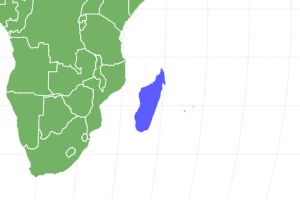Thought to be extinct until 1957!
Advertisement
Aye-aye Scientific Classification
- Kingdom
- Animalia
- Phylum
- Chordata
- Class
- Mammalia
- Order
- Primates
- Family
- Daubentoniidae
- Genus
- Daubentonia
- Scientific Name
- Daubentonia madagascariensis
Read our Complete Guide to Classification of Animals.
Aye-aye Conservation Status
Aye-aye Facts
- Prey
- Seeds, Insects, Larvae, Fruit
- Name Of Young
- Infant
- Group Behavior
- Solitary/Group
- Fun Fact
- Thought to be extinct until 1957!
- Estimated Population Size
- 1,000 - 10,000
- Biggest Threat
- Hunting and habitat loss
- Most Distinctive Feature
- Elongated middle finger with hooked claw
- Gestation Period
- 170 days
- Habitat
- Dense, tropical rainforest
- Predators
- Human, Fossa, Birds of Prey
- Diet
- Omnivore
- Average Litter Size
- 1
- Lifestyle
- Nocturnal
- Common Name
- Aye Aye
- Number Of Species
- 1
- Location
- Eastern coast of Madagascar
- Slogan
- Thought to be extinct until 1957!
- Group
- Mammal
Aye-aye Physical Characteristics
- Color
- Black
- Dark Brown
- Skin Type
- Fur
- Top Speed
- 20 mph
- Lifespan
- 10 - 23 years
- Weight
- 2kg - 2.7kg (4lbs - 6lbs)
- Length
- 36cm - 44cm (14in - 17in)
- Age of Sexual Maturity
- 2 - 3 years
- Age of Weaning
- 7 months
View all of the Aye-aye images!
Classification and Evolution
The aye-aye is a species of Lemur that is found inhabiting the rainforests of Madagascar. The aye-aye is not only the largest nocturnal primate in the world but is also one of the most unique.
It is in fact so strange in appearance, that it was thought to be a large species of squirrel when it was first discovered. The incisors of the aye-aye are ever-growing, much like a rodent. This animal evolved these strong teeth, as well as its skull and jaw, to maximize bite force in order to penetrate tree bark and gain access to insects. Even the rodent-like shape of its head helps improve that bite power!
In the mid-1800s the aye-aye was finally recognized as being a species of Lemur but was classified in a group of its own as their closest Lemur relatives remain a mystery even today. However, these incredibly unique animals are severely threatened throughout much of their natural habitat and were thought to be on the brink of extinction by 1980, primarily due to them being killed instantly by local people who believe that seeing an aye-aye is very bad luck. Although today’s population numbers seem to have risen, the aye-aye is one of Madagascar’s most endangered animal species.
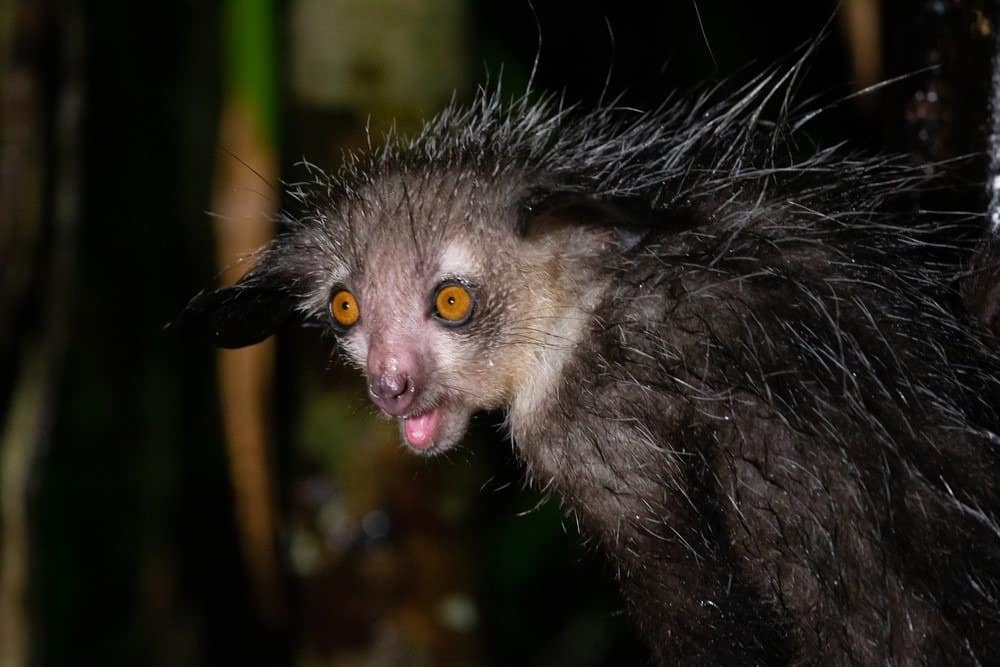
The aye-aye is so strange looking that it was thought to be a large species of squirrel when it was first discovered.
©Eugen Haag/Shutterstock.com
Anatomy and Appearance
The aye-aye is a primate that is most closely related to Lemurs but is one of the most unique animals on the planet due to the fact that it possesses a number of very distinct adaptations. Their body and long tail are covered in coarse, shaggy black or dark brown fur with a layer of white guard hairs that help them to blend into the surrounding forest in the dark. The aye-aye has very large eyes on its pointed face, a pink nose, and rodent-like teeth with incisors that grow continuously to ensure that they never become blunt. Their large rounded ears are incredibly sensitive giving the aye-aye excellent hearing when listening for grubs beneath the tree bark and are able to be rotated independently. The aye-aye has long and bony fingers with sharp pointed claws on the ends to help when dangling from branches, but it is the middle fingers on their front feet which are their most distinctive feature. Much longer than the others, these fingers are opposable with a double-jointed tip and a hooked claw on the end and are used for both detecting grubs in dead wood and then extracting them.
Learn about the ugliest animals in the world here.
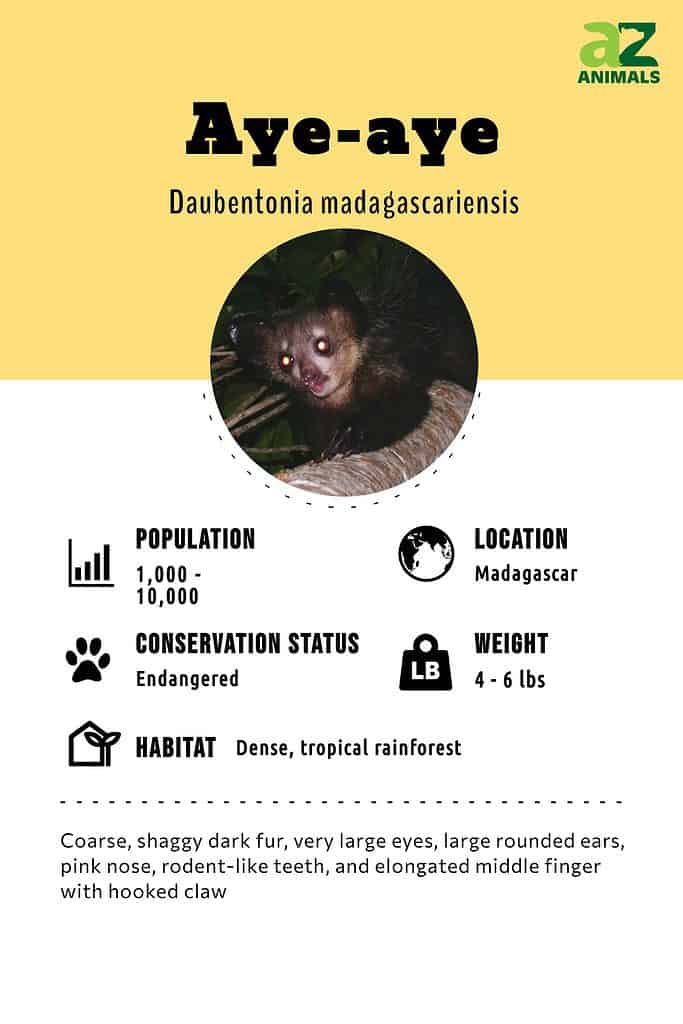
Distribution and Habitat
Historically, the aye-aye was an animal that inhabited the coastal forests of eastern and north-western Madagascar but by 1983 they were thought to be almost extinct with only a few scattered individuals known to still be found there. Since then their population numbers have increased and although these populations aren’t favorably big, they are found in an increasing number of locations and in a variety of different forest habitats. The aye-aye prefers dense, tropical, and coastal rainforest where there is plenty of cover but they are also known to inhabit secondary forests, bamboo thickets, mangroves, and even coconut groves along the eastern coast of Madagascar. However, along with the persecution of the aye-aye by local people they are severely threatened in their natural environment by habitat loss.
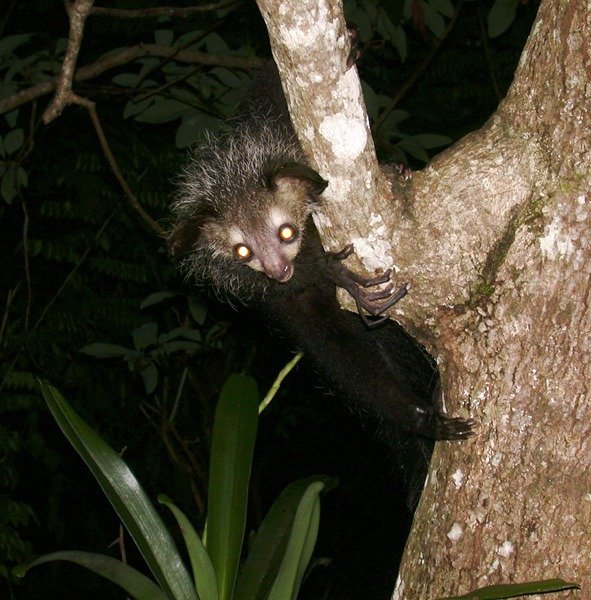
The aye-aye prefers dense, tropical, and coastal rainforests.
©Tom Junek, CC BY-SA 3.0, via Wikimedia Commons – Original / License
Behavior and Lifestyle
Like many other primates and lemurs, the unique aye-aye spends as much time as possible dwelling high in the tree canopy. Furthermore, the aye-aye keeps its activity in the nighttime and avoids daytime dangers. As arboreal animals, they maintain all daily activities while navigating treetops and living general life. The tree coverage helps camouflage aye-ayes from predators.
In order to sleep, rest, and raise their young, aye-ayes build circular nests in trees. These nests are created with a combination of vines, leaves, bark, and tree branches.
Aye-ayes were originally thought to be solitary animals, but recent research shows that they do sometimes act in groups. They do have large territories that can overlap with other aye-ayes. Males are even known to utilize others’ nests when not occupied.
Reproduction and Life Cycles
It was previously thought that the aye-aye had a very strict breeding season (in the same way as other Lemurs) when they actually seem to breed throughout the year, depending on when the female comes into season. When a female is ready to mate, she calls to male Lemurs who are known to gather around her and will fight aggressively with one another for breeding rights. After a gestation period that lasts for about five months, a single infant is born and spends its first two months in the safety of the nest, not being weaned until it is at least 7 months old. Young aye-ayes will remain with their mother until they are two years old and leave to establish a territory of their own. A female aye-aye is thought to be able to start reproducing when she is between 3 and 3.5 years old, whereas males seem to be able to do so at least 6 months earlier.
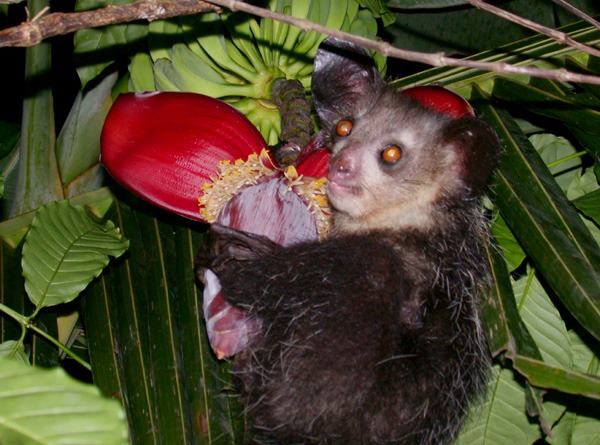
The aye-aye is an omnivorous animal that feeds on both other animals and plant matter, moving about high up in the trees and under the cover of night.
©Tom Junek, CC BY-SA 3.0, via Wikimedia Commons – Original / License
Diet and Prey
The aye-aye is an omnivorous animal that feeds on both other animals and plant matter, moving about high up in the trees and under the cover of night. Males are known to cover distances of up to 4km a night in their search for food, feeding on a variety of fruits, seeds, insects, and nectar. They are however specially adapted to hunt in a very unique way as they use their elongated middle finger to tap dead wood in search of the hollow tunnels created by wood-boring grubs, listening for even the slightest sound with their sensitive bat-like ears. Once the aye-aye has detected its prey it uses its sharp front teeth to gnaw a hole into the wood before inserting the long middle finger, hooking the grub with its claw, and extracting it (filling the same ecological niche as a Woodpecker). The aye-aye is also known to use this long digit to eat eggs and coconut flesh and is thought to be the only primate to use echolocation when searching for food.
Predators and Threats
The secretive and tree-dwelling lifestyle of the aye-aye means that it actually has very few natural predators in its native environment, with the agile and equally nocturnal Fossa being their most ferocious natural predator (along with Birds of Prey and Snakes that hunt the smaller and more vulnerable young). Humans are in fact the biggest threat to the aye-aye as populations have been obliterated in much of their native forests due to superstition from local people who believe that it is a bad omen to see one. In other areas where they are not feared in this way, the aye-aye is hunted as bushmeat. The biggest threat, however, to current populations is habitat loss caused both by deforestation and growing human settlements that encroach on the aye-aye’s natural habitat.
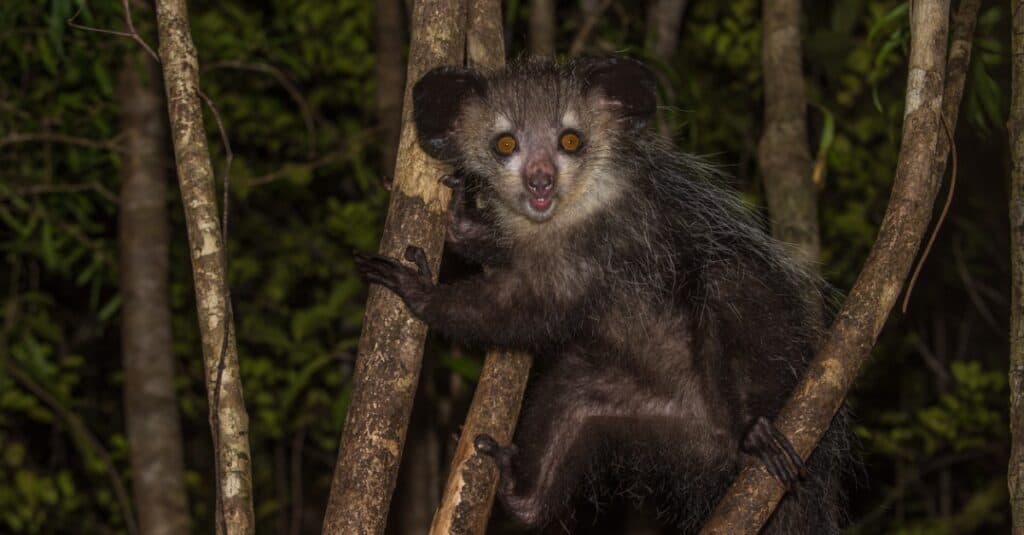
The secretive and tree-dwelling lifestyle of the aye-aye means that it actually has very few natural predators in its native environment.
©iStock.com/javarman3
Aye-aye Interesting Facts and Features
Although the aye-aye is a solitary animal, males have very loose territories that can overlap those of a number of others. They build their nests high in the trees and will rarely sleep in the same one two nights in a row. This means that one territory for an aye-aye can contain numerous nests, with up to six thought to be found in just one tree.
The aye-aye is thought to be one of the creepiest animals in the world with its name possibly believed to have come from the cry of alarm when a person spotted one. This may be an outdated line of thinking, however. Another suggestion is that the name aye-aye derives from the Malagasy language in such a way as to say that “one doesn’t know”. This would make logical sense if there was a great deal of superstition surrounding the aye-aye, in which locals did not even want to mention the name for fear of a curse or bad luck.
Despite now being found in more areas of its once vast range, aye-aye population numbers were once so low that they were actually thought to be extinct in the wild until 1957 when they were rediscovered.
Read more incredible facts about aye-aye here.
Relationship with Humans
The main reason why aye-aye population numbers have been critically low for years is that local people think that they are just too weird and many believe that seeing one is very bad luck indeed. One story says that if an aye-aye points its long middle finger at you that you will die, and another stresses that seeing one will lead to the death of a villager. The only way of stopping this in both cases is to kill the aye-aye as quickly as possible which has led to the extinction of populations in certain areas. Today though, the aye-aye is also faced with the increasing size of towns and villages that encroach on its native habitats with some individuals forced to invade crops to get food, which often leads to them being shot. They are also severely threatened by deforestation for the logging industry and to clear land for the creation of agricultural plantations.
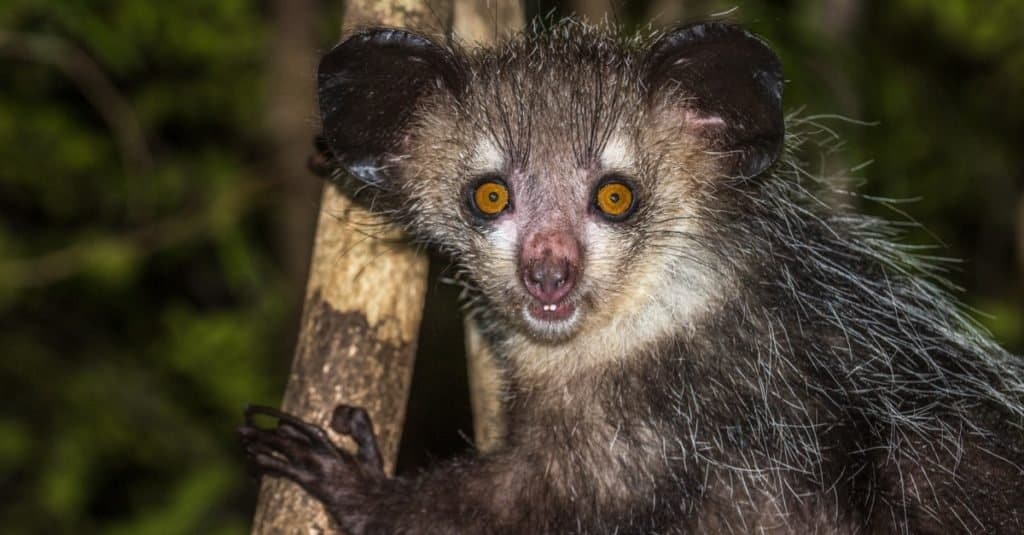
One of the weirdest animals is the Aye-aye, whose name originated from Malagasy people saying “heh heh” to avoid saying the name of a feared, magical animal.
©javarman/Shutterstock.com
Conservation Status and Life Today
Today, the aye-aye is listed by the IUCN as an animal that is endangered, meaning that it is severely threatened with possible extinction in the near future. Numbers have increased somewhat since the 1980s and small populations have been sighted in more areas of their natural range; however, they are still greatly threatened by the human activity going on around them. A number of captive populations can be found around the world in breeding programs to try and save the aye-aye from complete extinction. A small population can also be found on the island of Nosy Mangabe, which is a protected reserve just off Madagascar’s northeast coast.
View all 194 animals that start with AAye-aye FAQs (Frequently Asked Questions)
Are Aye Ayes herbivores, carnivores, or omnivores?
Aye Ayes are Omnivores, meaning they eat both plants and other animals.
What Kingdom do Aye Ayes belong to?
Aye Ayes belong to the Kingdom Animalia.
What class do Aye Ayes belong to?
Aye Ayes belong to the class Mammalia.
What phylum to Aye Ayes belong to?
Aye Ayes belong to the phylum Chordata.
What family do Aye Ayes belong to?
Aye Ayes belong to the family Daubentoniidae.
What order do Aye Ayes belong to?
Aye Ayes belong to the order Primates.
What type of covering do Aye Ayes have?
Aye Ayes are covered in Fur.
What genus do Aye Ayes belong to?
Aye Ayes belong to the genus Daubentonia.
Where do Aye Ayes live?
Aye Ayes live off the eastern coast of Madagascar.
In what type of habitat do Aye Ayes live?
Aye Ayes live in dense, tropical rainforests.
What are some predators of Aye Ayes?
Predators of Aye Ayes include humans, fossas, and birds of prey.
How many babies do Aye Ayes have?
The average number of babies an Aye Aye has is 1.
What is an interesting fact about Aye Ayes?
Aye Ayes were thought to be extinct until 1957!
What is the scientific name for the Aye Aye?
The scientific name for the Aye Aye is Daubentonia madagascariensis.
What is the lifespan of an Aye Aye?
Aye Ayes can live for 10 to 23 years.
What is a baby Aye Aye called?
A baby Aye Aye is called an infant.
How many species of Aye Aye are there?
There is 1 species of Aye Aye.
What is the biggest threat to the Aye Aye?
The biggest threats to the Aye Aye are hunting and habitat loss.
How many Aye Ayes are left in the world?
There are between 1,000 and 10,000 Aye Ayes left in the world.
How fast is an Aye Aye?
An Aye Aye can travel at speeds of up to 20 miles per hour.
What are the differences between tarsiers and aye-ayes?
The most distinct feature about tarsiers is their eyes, which are more prominent in proportion to the rest of the body. Other key differences between the two animals include their size, distribution and habitat, and diet.
How to say Aye-aye in ...
Thank you for reading! Have some feedback for us? Contact the AZ Animals editorial team.
Sources
- David Burnie, Dorling Kindersley (2011) Animal, The Definitive Visual Guide To The World's Wildlife / Accessed November 6, 2008
- Tom Jackson, Lorenz Books (2007) The World Encyclopedia Of Animals / Accessed November 6, 2008
- David Burnie, Kingfisher (2011) The Kingfisher Animal Encyclopedia / Accessed November 6, 2008
- Richard Mackay, University of California Press (2009) The Atlas Of Endangered Species / Accessed November 6, 2008
- David Burnie, Dorling Kindersley (2008) Illustrated Encyclopedia Of Animals / Accessed November 6, 2008
- Dorling Kindersley (2006) Dorling Kindersley Encyclopedia Of Animals / Accessed November 6, 2008
- David W. Macdonald, Oxford University Press (2010) The Encyclopedia Of Mammals / Accessed November 6, 2008
- Aye Aye Information / Accessed November 6, 2008
- Aye Aye Facts / Accessed November 6, 2008
- About Aye Ayes / Accessed November 6, 2008

